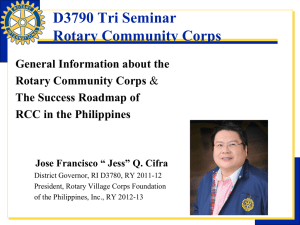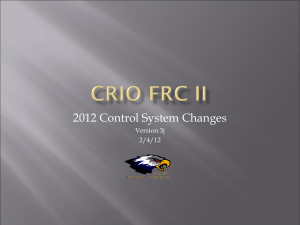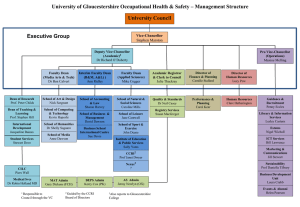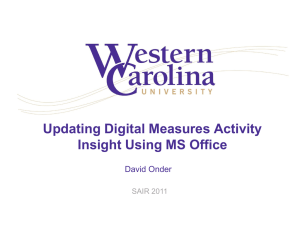DHHS-Cost Allocation Fundamentals
advertisement
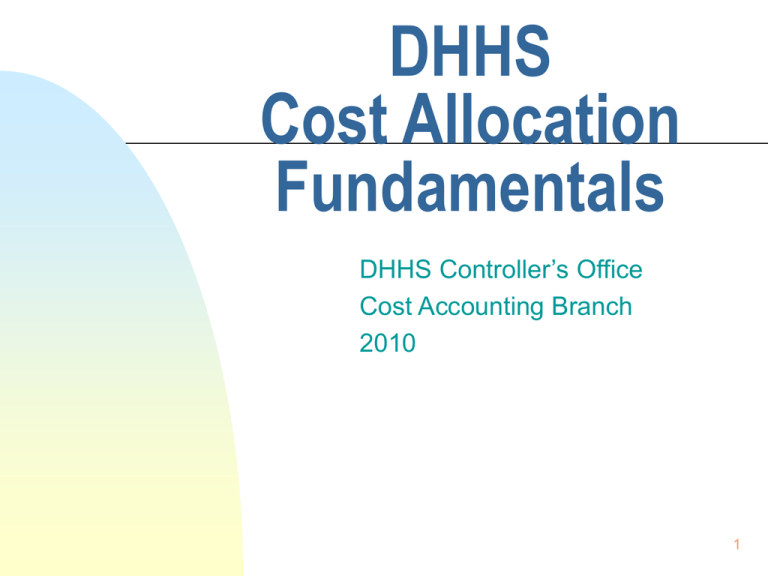
DHHS Cost Allocation Fundamentals DHHS Controller’s Office Cost Accounting Branch 2010 1 Types of Cost Plans Indirect Cost Rate - DPH, Schools for the Deaf Cost Allocation Plan (Non PA) - DIRM, Controller’s Office, Central Administration, DSBDHH, Dix rent Public Assistance Cost Allocation Plan (PACAP) DHSR, DDS, DSS, DMH/DD/SAS, DVR In general, a greater variety of federal funding sources and/or a greater variety of activities performed indicates the need for a Cost Allocation Plan rather than an Indirect Cost Rate. 2 Why Use Cost Allocation? NC wants to maximize federal revenues but the feds want to be sure they pay no more than their fair share - cost allocation provides a way to document costs justifiably attributable to various programs. Provides way for general administrative functions, managerial and supervisory personnel to earn federal funds based upon services performed or employees supervised. 3 Where to Start? Review Organizational chart. What do employees actually do? With which programs do they work ? Who supervises whom? Group like functions together into Cost Centers. Identify available funding sources - what services/activities are allowable under each source. Which programs “benefit” from the services performed? Choose statistical allocation bases. Analyze the functions being performed. What information is already available and what statistics will have to be gathered? All activities in an RCC should benefit the same programs and be allocated on the same basis. If staff costs are included in an RCC, all staff must have the same 4 supervisor. Examples of Allocation Bases Staff/Support Functions: Purchasing - # PO’s processed IT - # workstations maintained Personnel, clerical support - FTE’s served NonEmployee: Cost of space square footage Motor Pool - miles driven Photocopying copies made Direct workers: Consistent, measurable output - applications processed, calls received, case/recipient/ client counts, etc. Timesheets Supervisors: Positions supervised 5 Examples of Allocation Bases Currently Used in DHHS Division FTE’s Positions supervised # PCs County worker time Weighted data fields in EIS Computer usage recorded against specific application codes # of contracts Calls received by program # of transactions County expenditures Positions supported Timesheets Case counts - Medicaid, Economic Independence; Food Stamps, WF, etc. Client eligibility - Foster Care: IV-E, TANF, IV-B 1, etc. Purchase Order lines # of appeals hearings # of items mailed Systems operated 6 Direct charge A Word about Direct Charges and Allocating In order to direct charge to a federal funding source, all of the activities and all of the clients being served (if applicable) must be eligible for that funding source - for instance, EBT benefits only eligible Food Stamp clients. When you allocate costs to more than one federal program, you must include ALL benefiting programs. 7 Develop Cost Percentages for each Cost Center Develop percentages based upon allocation in each cost center. Example: 1110264299 Purchasing and Support Services - 2 Positions Allocated Based upon Purchase Order Lines Keyed Step 1: Funding Source State Funds Food Stamps TANF MOE Admin. Title IV-E Admin. IV-B 1, Child Welfare IV-D, Child Support Title IV-B 2, Safe & Stable Families Refugee Medical Asst. Medicaid SSBG Chafee Independent Living CAPTA Community Based Family Resource Grant Total FRC 00 F1 T5 K1 35 39 43 68 C5 QA 7R 37 54 Lines Keyed by Funding Source (Per NCAS Report) 189 46 133 15 23 805 37 13 2 7 2 3 5 1,280 % to Total 14.77% 3.59% 10.39% 1.17% 1.80% 62.88% 2.89% 1.02% 0.16% 0.55% 0.16% 0.23% 0.39% 100.00% Position Equivalent 0.2954 0.0718 0.2078 0.0234 0.0360 1.2576 0.0578 0.0204 0.0032 0.0110 0.0032 0.0046 0.0078 2.00 8 Cost Percentages (Con’t) Step 2 : Use Percentages to Allocate Cost Total cost for month of January = $6,423.45 Funding Source State Funds Food Stamps TANF MOE Admin. Title IV-E Admin. IV-B, Child Welfare IV-D Child Support Title IV-B II, Safe & Stable Families Refugee Medical Assistance Medicaid SSBG Chafee Independent Living CAPTA Community Based Family Resource Grant Total FRC 00 F1 T5 K1 35 39 43 68 C5 QA 7R 37 54 FFP 0.00% 50.00% 0.00% 50.00% 75.00% 66.00% 100.00% 100.00% 50.00% 75.00% 80.00% 100.00% 100.00% Allocation Total Cost Federal State/State Percentages Allocated Revenue Match 14.77% 948.74 0.00 948.74 3.59% 230.6 115.30 115.30 10.39% 667.4 0.00 667.40 1.17% 75.15 37.58 37.57 1.80% 115.62 86.72 28.90 62.88% 4039.07 2,665.79 1,373.28 2.89% 185.64 185.64 0.00 1.02% 65.52 65.52 0.00 0.16% 10.28 5.14 5.14 0.55% 35.33 26.50 8.83 0.16% 10.28 8.22 2.06 0.23% 14.77 14.77 0.00 0.39% 25.05 25.05 0.00 100.00% 6,423.45 3,236.23 3,187.22 9 Step-Up Cost Example Family Planning Coordinator (2 FTEs) RCC 2308 Family Planning Program(3 FTEs) Family Planning Admin. Support (1 FTE) RCC 2318 RCC 2312 (Direct Charge) (Time Sheet) 10 Family Planning Admin Support Time Sheet Summary (per time record) MCH Block Grant Medicaid Family Planning WIC Admin Preventive Health Block Grant Sub-total Leave,Other Totals FRC AP C3 FP GE PH Totals FRC AP C3 FP GE PH RCC2312 Hours 10.45 66.91 21.69 15.94 69.00 184.00 Hours Totals 10.00 64.00 20.75 15.25 66.00 176.00 8.00 184.00 RCC2312 Percent 5.68 36.36 11.79 8.66 37.50 100.00 Leave TOTAL Distr. RCC HOURS 0.45 10.45 2.91 66.91 0.94 21.69 0.69 15.94 3.00 69.00 8.00 184.00 8.00 184.00 RCC2312 Pos. Eq. 0.0568 0.3636 0.1179 0.0866 0.3750 1.0000 11 Employee Percentages Family Planning Admin. Support Funding Source MCH Block Grant Medicaid Family Planning WIC Admin Preventive Health Block Grant FRC AP C3 FP GE PH Total Percentage 5.68% 36.36% 11.79% 8.67% 37.50% Position Equivalent 0.0568 0.3636 0.1179 0.0866 0.3750 100.00% 1.0000 •Family Planning Program Funding Source FRC Family Planning FP Percentage 100.00% Position Equivalent 3.0000 12 Family Planning Coordinator (Step Up from Employees) Funding Source FRC 2312 FTE 2318 FTE Total FTEs Percentage 2308 FTEs MCH Block Grant AP 0.0568 0.0568 1.42% 0.0284 Medicaid C3 0.3636 0.3636 9.09% 0.1818 Family Planning FP 0.1179 3.1179 77.94% 1.5588 WIC Admin GE 0.0867 0.0867 2.17% 0.0434 Preventive Health Block Grant PH 0.3750 0.3750 9.38% 0.1876 4.0000 100.00% 2.0000 Total 1.0000 3.0000 3.0000 13 Components of the Cost Plan NC DHHS DSS Cost Allocation Plan RCC: 3035 Organizational Chart Cost Center Narratives Allocation Bases Identification of Benefiting Programs Section: V - AdFam Title: Local Support - Adult Programs Representatives Effective Date: 8-1-97 (retroactive to 7-1-97) Annual Budget: $631,734.00 Replaces: DCA Reference: NC DHHS DSS 97-7 Date Approved: 10-7-98 Description of Services Provided: The Adult Programs Representatives are responsible for providing supervision and guidance to county departments of social services regarding the services programs for aging and disabled adults and their families. The goal of the Adult Programs Representatives is to enable counties to develop, implement, and strengthen Adult Protective Services, In-Home Services, Adult Placement Services, Adult Care Home Case Management, AtRisk Case Management, State/County Special Assistance, and related services focused on independence, self-sufficiency, and family preservation. The Adult Programs Representatives work with the county departments to ensure compliance with Federal and State laws and policy and to promote good practice standards. Positions assigned to this cost center consist of (10) Social Services Regional Representatives. Allocation Base Definition: Costs are allocated to State/County Special Assistance, SSBG Admin. and Medical Assistance based on the ratio of filled positions in the 100 county DSS's. Source of Statistical Data: Final distribution Report for DSS-1571 reports reimbursed to counties. Time Period used: Prior Month X Benefiting Primary Program(s) list: SSBG Admin. Medical Asst. State - S/C-SA 14 Critical Elements of Narrative The narrative is the only document that goes to the federal agencies (DHHS: Division of Cost Allocation, ACF, CMS. USDA, etc.) for approval. Key pieces are: The cost center title. Seems elementary, but sometimes RCCs are re-used and the title isn’t changed. It’s very confusing to federal reviewers when the Description of Services and the Title don’t match. Description of services. Must be complete enough to explain activity in cost center and must clearly relate to the funding sources listed. Should not include NC acronyms or special program names, terminology, etc.., unless they are defined. 15 More Critical Elements Allocation base definition must provide enough information to explain choice of statistics to readers not familiar with detail of our processes. Listing of funding sources. Titles MUST correspond to federal terminology. 16 Plan Amendments Required for organizational changes, adding cost centers, change in activities resulting in change in benefiting programs, adding or deleting a funding source. Per OMB Circular A-87, Attachment D, Item D “State public assistance agencies are required to promptly submit amendments to the cost allocation plan to HHS for review and approval. ...The effective date of the plan or plan amendment will be the first day of the quarter following the submission of the plan or amendment, unless another date is specifically approved by HHS.” See also 45CFR95.515 17 Amendments - Who Does What? Division Responsibilities: Unit Supervisor makes organizational changes, identifies change in activities, identifies addition or loss of funding stream notifies other areas - Budget Office, Personnel, etc. Personnel - prepares PD 105s or PD 118s as necessary. Budget Office coordinates creation of new cost centers verifies funding stream changes prepares 606’s notifies Cost Allocation Branch and coordinates receipt of information needed by Branch for CAP Amendment. prepares CAP Update Request form. (See next slide.) 18 CAP Update Request Form CAP Update Request New Cost Center Directions for Completing CAP Amendment Request Revision to Existing Center Effective Date:__________________________ RCC # __________ Name ______________________________________Check if Title change Data for New RCC or Reasons for Change (check all that apply) : Inactive Add positions List: Positions Charged to RCC: Delete positions: Narrative update (explain in Justification) # Change only – old # __________ Add List: Supervising RCC RCC # ________ Funding Sources: Delete List: Contracts: Add List: Programs or Areas Cost Center Benefits: All or Other (List): Delete List: Allocation Basis Requested: Justification: (Include information on reorganizations, changes in State laws/mandates, changes in federal laws/mandates, previous audit findings, guidance from State or federal agencies, etc.) Requested by: Section: Program Section Official Date: Budget Officer 1. Check appropriate box to indicate a request for a new cost center or a change to an existing center. Complete effective date. This should always be the beginning of a month. 2. Fill in the RCC number and title. If the request is for a new RCC, the Division Budget Office will assign the number. Check the box as appropriate to indicate a change in the RCC title. 3. Complete the appropriate boxes in the Data section: a. Inactive - a cost center that is no longer is use – and is not anticipated to be used for the previous purpose – should be amended to be inactive. b. Positions Charged to RCC – positions should be listed by classification, e.g. 4 Social Services Program Consultants and 1 Office Assistant. c. Narrative update – check this box and explain in the justification section if the only change needed is a modification in the narrative. For example, the name of a lawsuit has changed because of a change in Secretary (Alexander vs. Flaherty) or the name of a group of clients has been changed (Thomas S. to mentally retarded/mentally ill [MR/MR]). d. Supervising RCC – indicate the RCC that supervises the staff in the RCC being created or indicate if the supervisory cost center has changed, thereby requiring an amendment. In the case of non-personnel RCCs, this block should be completed to indicate the RCC responsible for the activities in the RCC for which the form is being completed or, in the case of contracts, the RCC of the contract administrator. e. Funding Sources – list funding sources by the full, current title and indicate, if applicable, any qualifiers, such as Administration, Training, etc. f. Contracts – list contracts by Contractor. g. For new cost centers the Supervising RCC and Funding Sources sections must be completed. If the center will include charges for positions the Positions Charged section must be completed and for centers that include charges for contracts the Contracts section must be completed. 4. Check to indicate if the cost center benefits all functional areas and programs of the Division or list the areas it benefits by section and/or funding source. For example, list Economic Independence or Adult Mental Health if the cost center benefits all funding sources in those sections. If the cost center only benefits specific funding sources, list those sources, e.g. TANF and Food Stamps. 5. Indicate the allocation basis requested. In most cases this should be discussed in advance with the Cost Accountant in the Cost Accounting Branch assigned responsibility for the Division. Examples include: direct charge to one specific funding source, allocation based on positions served or supervised, Area Program payments for all services or for a specific disability only, County Worker FTEs, caseload by program, etc. 6. Complete the justification for the new center or for the change. The Cost Accountant in the Cost Allocation Branch will use this justification as the foundation for the Cost Center Narrative, so justifications should be as thorough as possible. 7. Fill in the name and Division Section of the person completing the form and indicate the date completed. 8. Fill in the name of the Division Program manager and the name of the person in the Budget Office with direct responsibility for the RCC. 19 Amendment Duties (con’t) Controller’s Office Responsibilities: Cost Allocation Branch prepares or revises narrative description of cost center with input from programmatic section and Division Budget Office. establishes or revises statistical base, if applicable, in collaboration w/Budget Office and program section. prepares financial impact analysis for affected cost centers submits amendment to feds for approval updates cost allocation databases to incorporate changes Federal Funds/Financial Reporting Branch establishes or inactivates federal fund codes if applicable processes federal draws based upon revised plan prepares federal financial reports 20 Mechanics of Cost Allocation (What actually happens during the month?) A/P processes invoices, Payroll processes payroll - items to be cost allocated are tagged with FRC 99, direct charges are tagged with FRCs denoting specific funding sources. Division personnel submit required timesheets, activity reports, logs, etc. from prior month to Cost Branch. Various statistical reports are generated by the Division & the Controller’s Office to develop allocation percentages for cost centers. 21 What happens (con’t) Cost Allocation prepares updated allocation statistics in Excel workbooks. Cost downloads or keys updated statistics into Access databases. Near end of the month, Cost prepares a simulated (“sim”) cost allocation. Various reports are processed following a sim to check for keying errors, missing validations, etc. 22 What happens (con’t) When General Accounting and the Division Budget Office confirm that all entries for the month have been completed and are correct, Cost prepares a non-simulated (“non-sim’) cost allocation run that interfaces with NCAS (“injects cost.”) Injecting cost creates multiple automatic entries that post revenues earned to the applicable RCCs and affixes the appropriate FRC to costs previously tagged with FRC 99. 23 How the entries look - Redistribution Scenario # 1 Payment made from 1140-2460-99 FRC 99 to be redistributed: a) A/P issues check for $10,000 to a vendor for printing services. Account 532850 DR CR $10,000.00 Cash DR CR $10,000.00 b) Cost injects and expenditures are allocated: Account 537170 Center 1140-2460-99 DR CR $10,000.00 Account 537170 Center 1140-2460-XX where XX is new FRC DR CR FRC 10 $286.00 FRC K1 340.00 FRC L2 403.00 FRC 35 96.00 FRC QA 8,871.00 FRC 7R 4.00 $10,000.00 24 Redistribution (con’t) c. Cost allocation interface posts the earned revenues to the applicable RCC and the receivable to Fund 1810. 53887K 53887L 53887F 53887Q 53887N Center 1140-2460 DR CR (FFP 50%) $170.00 (FFP 50%) 201.50 (FFP 75%) 72.00 (FFP 75%) 6,653.25 (FFP 80%) 3.20 7,099.95 53887K 53887L 53887F 53887Q 53887N Center 1810 DR $170.00 201.50 72.00 6,653.25 3.20 7,099.95 CR d. End results: Account 532850 DR CR $10,000.00 Account 537170 DR CR $10,000.00 $10,000.00 $0.00 FRC 99 DR $10,000.00 CR $10,000.00 $0.00 NOTE: The YTD balance for FRC 99 should always be $0 in the FRC expenditure report (DAPG 2605) after the cost interface. YTD balance for account 537170 is also $0. 25 How the entries look direct charge Scenario # 2 - Payment issued with FRC QA - Direct charge to SSBG a) Accounts payable issues a check for $10,000 to a vendor for printing 1140-2461-QA Account 532850 DR CR $10,000.00 Cash DR CR $10,000.00 With a direct charge, the redistribution account is not used. The expenditure will already show up in the FRC expenditure report (DAPG 2605) to the appropriate FRC. b. Cost injects and the cost allocation interface posts the earned revenues to the applicable RCC and the receivable to Fund 1810. (75% FFP) Account 53887Q Center 1140-2461 DR CR $7,500.00 Account 53887Q Center 1810 DR CR $7,500.00 26 Budgeting with Cost Allocation When transferring funds between Centers - even for what would otherwise be a Type 14 internal 606 - must take into account the relative amount of state $’s in each center. For example, need to increase Office Supplies in the Director’s Office (1110-1010-99) by $300. There is money available in the Information Systems Manager RCC (1110-1020-99). However, increasing $300 in center 1110-1010-99 only requires $78 in State funds (uncapped funds can be increased with no problem and this example assumes there is availability in all of the capped funding sources, such as SSBG). Reducing office supplies by $300 in center 1110-1020-99, however, frees up $134 of State funds. 27 SCHEDULE OF ANTICIPATED FEDERAL REVENUE FOR FUND BUDGET REQUIREMENTS, BY REVENUE OBJECT For Division of Public Health Based on the Divisional Cost Allocation Plan for the Month of: FUND: OBJ ============== = ========= ================== =================================== ======================== ============ ========== NCAS Acct. No. 53886C 5388AP 5388BK 5388AK 5388CB 5388AQ 5388BC 5388CD FRC Number: C3 AP PH FP GE AQ NC WW ------- ------------------ -------------------------------------------------------------- ------------------------------------------- --------------------- -----------------RCC No. | || FFP: 50.00% 57.14% 100.00% 100.00% 100.00% 100.00% 100.00% 75.00% -------------------------- | ---------------- -|| ================================================== ======================== ============ ========== RCC1010 | $300.00 || 3 7 24 8 10 12 1 3 RCC1020 | $300.00 || 0 21 15 7 6 7 8 2 ============ ========== ====================== ========== == ========== ================= 5388BJ 5388BQ 5388BN 5388CF 5388CM | Total Total JJ NL FJ JM FM | Federal NonCHECK --------------------- ------------------ ---------------------------------------- ------------------ | Share Federal Fed. + Non-Fed. 100.00% 75.00% 80.00% 100.00% 83.33% | Share - State = Total ============ ========== ====================== ========== == ========== ================= ========== 1 148 2 2 1 | 222 78 300 0 98 1 1 0 | 166 134 300 28 Budgeting (con’t) When budgeting new funding sources you must consider step-up costs (overhead) associated with supervisory and support positions as well as the remaining indirect cost pools. 29 Questions? 30



